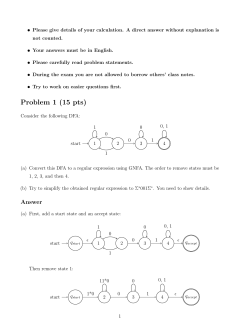
Assignment 1 (Lexical Analyzer)
Assignment 1 (Lexical Analyzer)
Compiler Construction CS4435 (Spring 2015)
University of Lahore
Maryam Bashir
Assigned: Saturday, March 14, 2015. Due: Monday 23rd March 2015 11:59 PM
Lexical analysis
Lexical analysis is the process of reading in the stream of characters making up the source code of
a program and dividing the input into tokens. In this assignment, you will use regular expressions
and DFAs to implement a lexical analyzer for a subset of C programming language.
Your Task
Your task is to write a program that reads an input text file, and constructs a list of tokens in
that file. Your program may be written in C, C++, Java or any other programming language.
Assuming that the input file contains the following code string:
2.1
Sample Input (C++ code)
void main ()
{
int sum = 0;
while(sum == 0)
{
sum = sum + 10.43 + 34E4 + 45.34E-4 + E43 + .34;
}
}
2.2
Sample Output
The output of the program should be similar to the following:
Class : Lexeme
keyword : void
identifier : main
1
(: (
): )
{: {
keyword : int
identifier : sum
=: =
num : 0
;: ;
keyword : while
(: (
identifier : sum
relop : ==
num : 0
): )
{: {
identifier : sum
=: =
identifier : sum
+: +
num : 10.43
+: +
num : 34.E4
+: +
num : 45.34E-4
+: +
identifier : E43
+: +
Error : .
num : 34
;: ;
}: }
}: }
Note: Program prints error on . and considers 34 a separate number. E34 is also treated as
identifier and not a number.
Valid Tokens
Programs in this language are composed of tokens displayed in table 1 :
2
Token Type
keyword
identifier
num
addop
mulop
relop
assignop
and
or
not
)
(
{
}
[
]
;
Lexical Specification
One of the strings while, if, else, return, break, continue, int ,
float, void
Token Id for identifiers matches a letter followed by letters or digits
or underscore:
letter → [A-Z | a-z]
digit → [0-9]
id → letter (letter | digit | )∗
Token num matches unsigned numbers:
digits→ digit digit∗
optional-fraction → ( . digits) | optional-exponent → (E(+ | − | ) digits ) | num→ digits optional-fraction optional-exponent
+,∗, /
<, >, <=, >=, ==, ! =
=
&&
||
!
)
(
{
}
[
]
;
Table 1: Table of lexical specifications for tokens
3
Construction of Deterministic Finite Automata (DFA) or Transition Diagrams
You can construct single DFA (also called transition diagram) for recognizing all tokens in this
language by combining individual DFAs for each type of token. For example you can construct
transition diagram for identifiers and numbers and them merge the start states of two diagrams to
create a single transition diagram that recognizes both numbers and identifiers.
For identifying keywords, you can store keywords in some data structure (hashmap or string
array). Whenever your program recognizes a token of identifier, you can check your map or string
array if this identifier matches any keyword. If it matches any keyword then consider it keyword
otherwise consider it identifier.
Implementation of Deterministic Finite Automata (DFA)
I have written a small lexical analyser for a simple DFA shown in figure 1. You can find its source
code (”Lexer.java”) on Piazza site. You can either make changes to this code or write your own
lexical analyser from scratch. You can also write C++ version of this Java code if you want to
program in C++.
Please note that this DFA is not correct DFA for this assignment. It is just a
sample DFA to give you an idea of how to convert your DFA to code. For example
this DFA only allows letters in an identifier whereas in your C language you can use
digits and underscore in identifier as well.
Submission
Email a zip file containing your complete project (all source files, along with whatever other files
are needed to compile them; sample input and output files) to the following address:
maryam.bashir@cs.uol.edu.pk
The name of zip file should be roll numbers of all students in the group as follows:
RollNumber1-RollNumber2
You should try to work on this assignment individually. If you think your programming is very
weak then you can work in group size of maximum 2 students.
4
whitespace
*
7
8
other any
6
letter
whitespace
any
any
error
other
0
letter
digit
=
*
1
2
other
3
4
any
*
5
digit
any
Figure 1: DFA
1
5
© Copyright 2025









